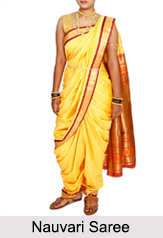 A single nine-yard cloth, the Nauvari saree, holds immense significance as the traditional attire of women in Maharashtra, India. This saree, also known as Sakachcha or Kaashtha saree, derives its name from the way it is draped, with the saree tucked at the back. As an Akanda Vastra, meaning it doesn`t require any additional attire for support, the Nauvari saree embodies the essence of Maharashtrian culture and tradition that has been cherished by women in the state for generations. This versatile garment has been worn not only during religious and cultural events but also by women engaged in farming and even during times of war.
A single nine-yard cloth, the Nauvari saree, holds immense significance as the traditional attire of women in Maharashtra, India. This saree, also known as Sakachcha or Kaashtha saree, derives its name from the way it is draped, with the saree tucked at the back. As an Akanda Vastra, meaning it doesn`t require any additional attire for support, the Nauvari saree embodies the essence of Maharashtrian culture and tradition that has been cherished by women in the state for generations. This versatile garment has been worn not only during religious and cultural events but also by women engaged in farming and even during times of war.
Types of Draping a Nauvari saree
A Nauvari saree is mainly draped in two types. One is the traditional type that has been in practice since ages and another is a Koli style which has a slight variation and is mainly popular among the koli community in Maharashtra.
Tradional drape: The traditional drape of the Nauvari saree is a hallmark of Marathi style, typically worn without a petticoat. However, the draping style varies based on the region and topography. For instance, Brahmin women have their unique way of draping called "brahmni," while the Aagri people of the Raigad district opt for a knee-length fashion known as "adwa patal."
In contrast, rural women from Pune, Satara, Ahmed Nagar, and Kolhapur prefer an ankle-length drape, which has gained popularity. The distinctive feature of the adwa patal and uprati drapes is that they don`t involve tying knots but are still tightly draped. Brahmins showcase the saree`s border on both the front and back sides, similar to the kashta style. The Nauvari saree`s center is neatly placed at the back of the waist, securely tied in the front, and then wrapped around the legs. The decorative ends are draped over the shoulder and the upper body, creating a regal appearance. This style gained prominence during the Peshwai reign and continues to be revered to this day.
Koli-style Drape: The Koli tribe also embraces the Nauvari saree, but in a distinct way. They divide the saree into two pieces, with one piece worn around the waist and the other used to cover the upper body. The saree is taken over the left shoulder in the Maratha fashion, lending grace to the wearer`s movements. Koli women, known for their decorative dress and ornaments, skillfully drape the nine-yard cotton fabric over their hips, enhancing their figure`s elegance during motion.
Traditional Use of Nauvari Saree
The traditional Nauvari saree, also referred to as Lugada, has retained its charm even in the modern age. While it is predominantly worn by elderly Maharashtrian women, there is a growing trend among the younger generation to revive this age-old Marathi tradition. The saree`s perfect technique, practice, and grace demand skill from the wearer. It finds its place in dance competitions like "lavani" and Maharashtrian folk dance, making a remarkable comeback in the fashion industry.
The saree`s ability to evoke a sense of grace, trendiness, and comfort has made it an iconic fashion choice. Even the women dabbawalas in Mumbai proudly dress in nauvari sarees, showcasing their respect for tradition.
To ensure ease and comfort in wearing the saree, the market now offers stitched versions for those who love the drape. Ready-to-wear nine-yard sarees are becoming increasingly popular, especially for occasions where wearers may lack the necessary technique. These sarees provide a quick solution by allowing wearers to don them like a salwar, with the pallu draped over the shoulder. Marathi movies have played a significant role in keeping this traditional attire alive, and the availability of stitched sarees has further eased its adoption.
The Nauvari saree, with its rich heritage and aesthetic appeal, continues to be an emblem of Maharashtrian culture and tradition. Whether worn by elderly women or embraced by the younger generation, the Nauvari saree exudes grace, elegance, and a deep-rooted connection to the state`s history.





















